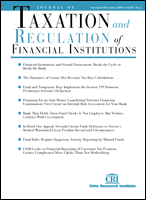Proposals Regarding the Taxation of Credit Default Swaps
Author: David Garlock.; Yoram Keinan.; Howard Leventhal.; Alan Munro.
Source: Volume 18, Number 06, July/August 2005 , pp.5-16(12)

next article > |return to table of contents
Abstract:
This article is based on a letter1 written in response to the request by the IRS in Notice 2004-522 (the “Notice”) for further information regarding credit default swaps (“CDSs”) and market participants in CDS transactions and for recommendations regarding the taxation of CDSs. The authors’ principal recommendations are that Treasury and the IRS should confirm in published guidance that: 1. Payments made by a U.S. buyer of a CDS will not be subject to withholding tax (if made to a foreign protection seller). 2. Level periodic payments by a CDS buyer will be deductible as an ordinary expense when paid or accrued. 3. Amounts received by a U.S. buyer from the seller upon a credit default event will be treated as capital gain if the CDS or the underlying reference obligation is a capital asset (or would be a capital asset if owned by the buyer). No amount attributable to a possible future receipt of such a payment will be subject to federal income tax prior to the time that the right to receive such a payment becomes fixed or, in the case of a cash method protection buyer, until such payment is received. The authors think that the simplest and best way to achieve these results would be to treat CDSs as notional principal contracts.3 This would achieve directly the first two of the above recommendations. To reach the other two results, we urge that special timing and character rules be added to the notional principal contract regulations as part of the process of finalizing the proposed regulations dealing with contingent notional principal contracts. This article will proceed as follows: The first part, Market Uses of Credit Default Swaps, sets forth the main reasons that market participants enter into CDSs and describes the economics of such contracts. The second part, The Four Analogies, discusses the four alternative analogies suggested in the Notice and compares their predominant characteristics with those of a CDS. The third part discusses timing issues, the fourth part character issues, and the last part discusses sourcing and withholding issues.Keywords:
Affiliations:
1: Ernst & Young LLP; 2: Ernst & Young LLP; 3: Ernst & Young LLP; 4: Ernst & Young LLP.